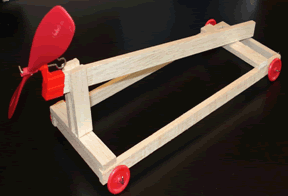

Propeller-driven Vehicles
Why is this important?
In the Design section we learned that propellers generate thrust by rotating an airfoil in a circle which generates thrust by accelerating fluid backward away from the propeller. The shape of the airfoil and size of the propeller are carefully selected so that the propeller provides the required thrust with a high propulsive efficiency. In this activity we will use a rubber band powered propeller car to understand some of the key characteristics that affect the thrust and efficiency of propeller propulsion.
[Note: Although jets and propellers have key differences, much of the basic physics is the same, so many of the procedures in this activity will be similar to those in Activity 2 (Balloon-powered car).]
What do I need?
A rubber band powered propeller car [recommended propeller car kits: Doc Fizzix Rubber Band Aero Racer, Kidz Lab Propeller Engines (car and boat). Materials required to assemble the Aero Racer: Glue, needle-nosed pliers, a ruler, and a pencil.]
An extra propeller or a second car kit
Scissors
Measuring tape
Stopwatch
Scale or balance
How do I do it?
Assemble the car according to the instructions included with the kit. Be careful to follow the instructions carefully. When you are finished, they should look something like the pictures shown below:

Kidz Lab Propeller Engine Car |

Doc Fizzix Rubber Band Aero Racer |
Using the scissors, cut off the outer 2 cm of each propeller blade on the second propeller (or the propeller on the second car if you have two car kits). Using the measuring tape, measure the radius of each propeller and record the measurements. Finally, find the mass of the vehicle with each propeller using the scale or balance. Now you are ready to make some measurements of propulsive performance.
Range
When you wind up the propeller, you are storing energy in the rubber band that is released when you let the car go. The more times you wind the propeller, the more energy you store and therefore, the further the car should go. To investigate this we will measure the range of the propeller car with both the large and small propellers for different numbers of turns of the propeller (N).
Procedure:
| 15 turns | 20 turns | 25 turns | 30 turns | |
|---|---|---|---|---|
| Small Propeller | ||||
| Large Propeller |
When you have completed the table, make a plot of R vs. N. Include the results for both propeller radii on the plot so you can compare them. N is the independent variable in this experiment, so put it on the horizontal axis.
Thrust
In the range experiments, you probably observed that the car accelerates while the rubber band unwinds and then coasts to a stop after the rubber band has unwound. By Newton's 2nd Law, the car accelerates in proportion to the thrust applied by the propeller as the rubber band unwinds. Thus, we can measure the average thrust supplied by the propeller by measuring the car's acceleration.
Procedure:
| 15 turns | 20 turns | 25 turns | 30 turns | |
|---|---|---|---|---|
| Small Propeller | L: t: |
L: t: |
L: t: |
L: t: |
| Large Propeller | L: t: |
L: t: |
L: t: |
L: t: |
Assuming approximately constant acceleration while the rubber band unwinds, acceleration may be computed from

Then thrust may be computed from Newton's 2nd Law, namely,

where m is the mass of the car measured previously. Compute the thrust for each of the measurements made. Make a plot of FT vs. N for both propeller sizes.
Efficiency
As discussed in the Principles section, overall efficiency is the ratio of power output to rate of energy input. Or equivalently, it is the work output over the total energy input. In this case the propeller is doing work only while the rubber band is unwinding (no work is done by the propeller during the coasting phase). Thus, the work done by the propulsion system is
The total energy input to the propeller is the energy stored in the rubber band during winding. The energy stored in the rubber band is proportional to N2. Thus, we may say the efficiency obeys

Compute FTL/N2 for the data taken in the thrust experiment and plot FTL/N2 vs. N. Note that we are not computing the efficiency directly, only something that is proportional to efficiency. Also, we have assumed thrust is constant during car acceleration (which is not precisely true). Nevertheless, your plot of FTL/N2 vs. N should give an approximate indication of how efficiency depends on N and propeller size.
What did you observe?
Range
How does range depend on N? Does it follow the expected trend? Based on your results, what could you do to improve the range?
Thrust
The general equation for thrust is
![]()
Although it is difficult to measure directly, the area of the jet produced by the propeller (Ae) is reduced if the propeller diameter is reduced. Using this knowledge, what do your results indicate about how changing Ae affects thrust? Is Ae the only thing in the thrust equation that is changed when the propeller radius is changed? If not, how you can you tell?
How does changing N affect thrust? Why? Hint: Think about how rate of spin of the propeller is related to Ve. Remember that propellers work by generating "lift" in the forward direction and the amount of lift is a reflection of how quickly the fluid has been accelerated away from the wing.
Efficiency
How did changing N affect efficiency? Which propeller size was most efficient? For the propeller car, the thermal efficiency of the rubber band is close to 1, so the overall efficiency and propulsive efficiency are approximately the same (ηo ≈ ηp). Can you use the equation for steady-state propulsive efficiency to explain your observations about propulsive efficiency? Hint: think about how changing N or propeller radius affects Ve.
